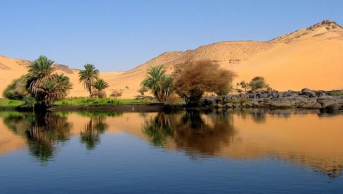On the Evolution of Transboundary Aquifer Law and the Middle East

There are nearly half a thousand international agreements concerning the management of transboundary water resources. Despite it accounts for at least 50% of current water supplies globally, groundwaters are handled by only a very small percentage of these agreements. With respect to Middle East, there are currently four agreements explicitly regulating transboundary groundwaters. These are the Convention between Syria and Lebanon on the Distribution of Al-Asi (the Orontes) River (1994), the Jordan-Israel Peace Treaty (1994), the Interim Agreement between the Palestine Liberation Organization and Israel (1995), and the Agreement between the Government of the Hashemite Kingdom of Jordan and the Government of the Kingdom of Saudi Arabia for the Management and Utilization of the Ground Waters in the Al-Sag/Al-Disi Layer (2015).
When compared with the legal advancement in regulation of transboundary surface waters, the development of international law governing the transboundary groundwaters was rather sluggish. One of the main reasons behind this was the gap in terms of data with regards to water resources beneath the earth. Also, transboundary groundwater resources appeared as the last resort for many countries which –quite rationally- first intensified their efforts for expanding their utilization of surface waters, which are less costly to do; and their national groundwater sources, which did not require lengthy negotiations with another country, like sharing and utilization of transboundary aquifers necessitated.
However, this era has come to end. Transboundary aquifers have now become under intense pressures for utilization. Unregulated use can pose catastrophic risks particularly for so-called ‘fossil’ aquifers, which are not being replenished. These aquifers are of the greatest importance for some Middle East countries where grave lack of water resources threatens the viability of states and societies. Aquifers of this kind simply represent the ‘water guarantees’ for future generations. Although it is very doubtful that codification of legal principles may bring about a scheme of perfect protection, still it can serve as ‘beacons’ for states entering into negotiations for sharing and protecting these vital water sources.
Currently we have a set of 19 draft articles on the law of transboundary aquifers. In 2008, it is adopted by the International Law Commission at its sixtieth session. Finally, the UN’s General Assembly adopted a Resolution on 16 December 2013. The main aim of the draft was to establish a holistic understanding. It reads ‘‘all the transboundary aquifers and aquifer systems will be governed by the present draft articles, regardless of whether they are hydraulically connected to international watercourses.’’
Sovereignty, the most fundamental principle of the international law is underlined in the beginning, in Article 3, which reads “each aquifer State has sovereignty over the portion of a transboundary aquifer or aquifer system located within its territory. It shall exercise its sovereignty in accordance with international law and the present articles.’’
This centrality of the concept of sovereignty is, then, tried to be balanced with mentioning of a number of principles such as the ‘backbone‘ principle of ‘equitable and reasonable utilization’. According to the Article 4, which mentions and provide detailsabout this principle, .”Aquifer States need to utilize transboundary aquifers or aquifer systems according to the principle of equitable and reasonable utilization, taking into account of the following: ‘’(a) They shall utilize transboundary aquifers or aquifer systems in a manner that is consistent with the equitable and reasonable accrual of benefits therefrom to the aquifer States concerned; (b) They shall aim at maximizing the long-term benefits derived from the use of water contained therein; (c) They shall establish individually or jointly a comprehensive utilization plan, taking into account present and future needs of, and alternative water sources for, the aquifer States; and (d) They shall not utilize a recharging transboundary aquifer or aquifer system at a level that would prevent continuance of its effective functioning.”
According to the text, utilization of a transboundary aquifer or aquifer system in an equitable and reasonable manner shall mean “taking into account all relevant factors, including: (a) The population dependent on the aquifer or aquifer system in each aquifer State; (b) The social, economic and other needs, present and future, of the aquifer States concerned; (c) The natural characteristics of the aquifer or aquifer system; (d) The contribution to the formation and recharge of the aquifer or aquifer system; (e) The existing and potential utilization of the aquifer or aquifer system; (f) The actual and potential effects of the utilization of the aquifer or aquifer system in one aquifer State on other aquifer States concerned; (g) The availability of alternatives to a particular existing and planned utilization of the aquifer or aquifer system; (h) The development, protection and conservation of the aquifer or aquifer system and the costs of measures to be taken to that effect; (i) The role of the aquifer or aquifer system in the related ecosystem.”
On top of this hierarchy, the text emphasizes the ‘special regard shall be given to vital human needs’. Other major principles that have been upheld by the text of draft articles include ‘obligation not to cause significant harm’, ‘general obligation to cooperate’, and ‘regular exchange of data and information’. Thus, the text, in a nutshell seeks to balance between fundamental modus operandi of the nation-states, i.e. sovereign equality of states, and growing needs for just sharing and effective protection of transboundary aquifers.
To conclude, groundwaters have become one of the focal points of attempts for developing an international legal framework for sharing of freshwater sources across countries. The draft articles do not try to fundamentally alter the accepted norms of the customary international law. Rather it can be seen as an extension of the law on transboundary surface waters to the realm of groundwaters, which are physically interconnected. Although it can be regarded as being in its infancy, a prospect of internationally recognized set of legal norms for governing transboundary aquifers appeared on the horizon. The Middle East is and will be a perfect laboratory to test this evolving legal paradigm. Given the relentlessly increasing stress on the aquifers in almost all parts of the Middle East, the 21st century will likely be marked by proliferation of negotiations and hopefully agreements on shared sources of groundwaters in this part of the globe.









